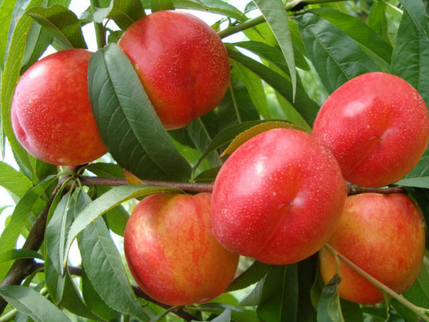According to many years of the survey found that the main pests and diseases are the following greenhouse nectarine, now the causes and prevention measures are described below: First, bacterial perforation 1, the cause of the disease: high air humidity is an important condition for the occurrence of bacterial perforation. Soil stickiness, partial application of nitrogen fertilizer, declining tree potential, excessive planting density in the solar greenhouse, and poor ventilation and light transmission are all conducive to the disease. 2, prevention and treatment methods: increase the application of organic fertilizer to improve disease resistance. Before warming up the greenhouse, it should be properly trimmed to make the tree body ventilated and well-transparent; at the same time, the dead branches, diseased leaves and fruit drop should be completely removed, and burned or buried deeply to eliminate the wintering bacteria source. After the greenhouse is warmed up, it is necessary to strictly control the temperature, especially the flowering period, to strictly control the number of irrigations and the amount of irrigation, and to ventilate in time. When the perforation disease occurs seriously, 45% of the sensitized ammonium 800 times solution, or 65% of the sensitized zinc 500 times solution, and 72% of the agricultural streptomycin WP 3,000 times solution can be sprayed. Generally, it is sprayed once every 10 to 15 days, and sprayed a total of 3 to 4 times. Second, peach brown rot 1. Causes of the disease: The pathogen mainly overwinters on hyacinth or diseased branches. After the greenhouse warms up, a large number of conidia will be produced on the stiff fruit, which will spread through the airflow and water droplets, causing the initial infection. Initially, the percutaneous hole invades the fruit, and in the later stage, the fruit is mainly invaded through various wounds. In the fruit ripening period, the warm and humid environment is seriously ill. 2, prevention and treatment methods: Before the greenhouse warms up, it is necessary to completely remove the dead and diseased branches on the trees and underground, and minimize the source of initial infection. Timely control of pests can also reduce the occurrence of peach brown rot. Spray 5 times of melodyrite before spraying in the greenhouse. 10 days after the flowering, every 10 to 15 days, spray once, stop the drug 20 days before the harvest, the available agents are: 65% Dyson zinc wettable powder 500 times liquid, 70% methyl thiophanate Wettable powder 1000 times solution, 50% carbendazim wettable powder 800 times solution. Three, peach leaf miner 1. Occurrence law: Peach leaf miner occurs in multiple generations a year. The larvae are sneaked into the mesophyll for feeding. The leaf meat is eaten into a curved tunnel from fine to thick, and the worm is stuffed in it. The skin of the victim is white, but not rupture, severe yellow leaves, causing early leaf, flower bud formation and a great influence on tree growth and development. 2, prevention and treatment methods: artificial control. Before the overwintering adult worms are emerged, the leaves and weeds in the peach garden are completely removed and burned intensively to eliminate the overwintering or adult worms. Sex pheromone adulticides: is selected from a wide-mouth container, filled with water to the edge of 1 cm, add a little water and detergent, and then with a fine wire string containing rubber lure Lyonetia adult moth pheromone formulations, fixed on the container In the center of the mouth, it is a trap. The traps are hung in the peach garden. The height is 1.5 meters from the ground and 5 to 10 per acre. Chemical control. Pupa and adult emergence period is a critical period of chemical control. Commonly used agents: 25% chlorpyrifos 1500 suspension, 20% cypermethrin 2000 times solution, 2.5% bromine-deltamethrin emulsion 3000 times solution, 20% chlorpyrifos 4,000 times solution. Four peaches 1, Occurrence: Myzus persicae occurred 10 to 20 years of generations 1, ovum next peach bud, axillary buds, bark and small twigs etc. cracks Winter. After the eggs hatch into nymphs major damage peach buds, then harm peach leaf. 2, prevention and treatment methods: artificial control. Using the hawthorn to move back to the peach tree to lay eggs in the Autumn, the artificial defoliation is carried out before the natural leaves of the peach tree, so that the relocated locusts can live in the distance and cannot cross the tail and lay eggs, so as to reduce the source of the leap year. Chemical control. The key period of chemical control is the germination period of peach buds. Commonly used medicaments are 10% imidacloprid wettable powder, 10% once clean wettable powder 3000 times liquid, 2.5% turmeric wettable powder 2000 times liquid, 50% anti-converse wettable powder 2000 times liquid. After the peach tree has fallen, if the mites are still harmful, the above pesticides can be sprayed once more. All our high visibility workwear are produced strictly according to standards European EN13688,EN ISO20471, EN343, EN11611, EN11612, EN1149; American ANSI/ISEA 107-2015, Canadian CSA Z96-15 and Australian AS/NZS 1906.4, AS/NZS 4602. hi vis polo shirts,hi viz shirts,high vis shirt,hi vis safety shirts Ningbo Staneex Imp. & Exp. Co., Ltd. , https://www.staneex.com
As a safety apparel manufacturer and exporter,which eastablished for 20 years.Any question about us or product,please send inquery and email to contact us